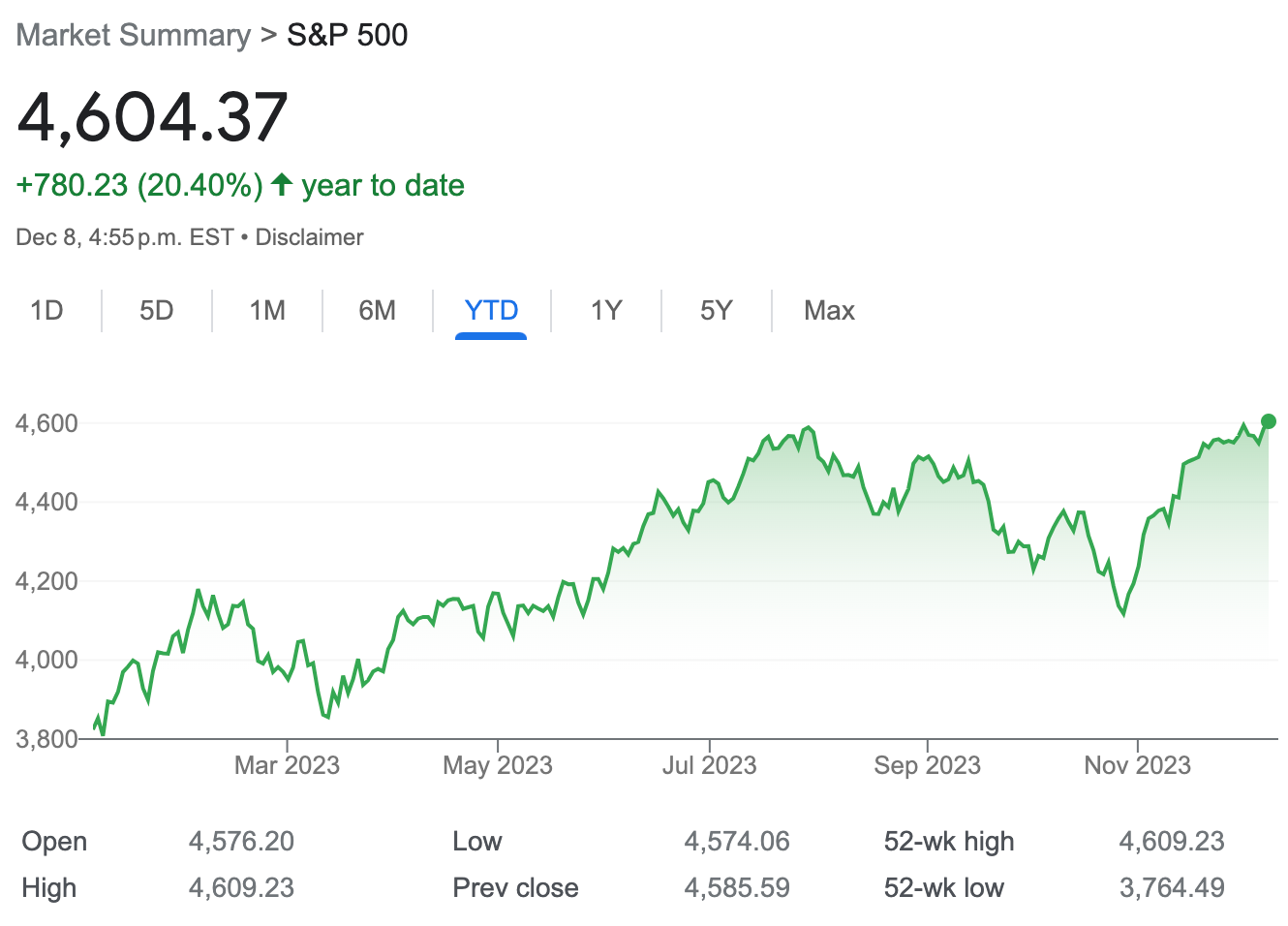
How to invest in the S&P 500 index
FrankHH / Shutterstock
Updated: December 22, 2023
We adhere to strict standards of editorial integrity to help you make decisions with confidence. Please be aware that some (or all) products and services linked in this article are from our sponsors.
We adhere to strict standards of editorial integrity to help you make decisions with confidence. Please be aware that some (or all) products and services linked in this article are from our sponsors.
Back in early 2023, financial outlets headlines were painting a gloomy future.
"Every person on TV says recession. Every economist says recession. I’ve never seen anything like it,” said economist Mark Zandi of Moody’s Analytics, an expert in economic forecast.
Fast forward to December 2023 and the S&P 500 index rewarded its shareholders with a 20% growth, continuing to challenge hedge fund managers set to beat the index.
Before 1975, if you wanted to buy the 500 stocks in the S&P 500, you would have had to buy each stock individually. Vanguard founder John Bogle introduced the first-ever index fund in that pivotal year, which tracked the S&P 500.
These days, there are many S&P 500 index funds to choose from. Read on to find out everything you need to know about how to invest in the S&P 500 index.
Low-Cost and Passive Strategy S&P 500 investing strategy: S&P 500 tracking funds typically have low management fees and follow a passive investment approach, mirroring the index's performance with minimal intervention.
What is the S&P Index?
Short for Standard & Poor's 500, this index tracks the performance of 500 of the most significant publicly traded stocks in the U.S. While there are many other index funds, the S&P 500 is perhaps the most famous stock market index in the United States.

A committee meets to choose the stocks in the index, and they don't necessarily have to be the biggest 500 companies. The committee looks at things like market capitalization, liquidity, sector, and other criteria. To qualify, a company must be a large-cap company with a minimum $14.6 billion market cap (as of March 2022).
Continue reading: How to invest in index funds
How to invest in the S&P 500 Index
The S&P 500 isn't the only index in the U.S. but it's a great place to start investing.
That's because it includes most of the biggest companies in the U.S. And since S&P 500 index funds don't need fund managers to pick and choose the underlying stocks, they tend to have much lower fees than actively-managed mutual funds.
If you're looking to invest in the S&P 500, then follow these four steps:
1. Open a brokerage account
If you want to invest in the S&P 500, you'll first need a brokerage account. This could be a retirement account like a traditional IRA or Roth IRA, an employer-sponsored 401(k) or similar, or your own traditional, taxable brokerage account.
There are many online brokerages to choose from. Look at fees for buying and selling mutual funds and ETFs if you open a new account intending to invest in the S&P 500. Many brokerages offer their own family of funds or a group of partner funds with no mutual fund trading fees.
Most of the top stock brokers today now offer commission-free trading for U.S.-listed stocks, options, and ETFs. They all provide investors with research and educational tools so that even rank beginners can figure out what to do. Here's a quick comparison of three top platforms.
| Highlights | Robinhood | E*TRADE | Ally Invest | Public.com |
|---|---|---|---|---|
| Rating | 4.3/5 | 4.5/5 | 4.4/5 | 3.5/5 |
| Min. investment | $0 | $0 | $0 | $0 |
| Stock trades | $0/trade | $0/trade | $0/trade | $0/trade |
| Options trades | $0 | $0.65/contract | $0.50/contract | N/A |
| Crypto trades | ✅ | ❌ | ❌ | ✅ |
| Mutual funds | ❌ | ✅ | ✅ | ❌ |
| Virtual trading | ✅ | ✅ | ❌ | ❌ |
| Get started today | Open account | Open account | Open account | Open account |
| Learn more | Robinhood review | E*TRADE review | Ally Invest review | Public.com review |
2. Choose between mutual funds or ETFs
You can buy S&P 500 index funds as either mutual funds or ETFs. Both track the same index and work similarly, but there are some key differences you should know about.
- 1.
Mutual funds are intended to be owned for a relatively long period of time. They trade only once per day, after the market close. Some have a minimum investment amount and a minimum length of time to invest. And early withdrawals can lead to penalties. On the positive side, you can buy and sell mutual funds in round dollar amounts.
- 2.
ETFs are bought and sold like a stock. The price constantly changes throughout the day as traders buy and sell. Most major discount brokerage firms allow you to trade all ETFs free. There is no minimum time to hold or minimum purchase amount aside from a single share price. ETFs may have lower expense ratios in some cases as well and can be purchased via brokers like Public.com, which is known for its low fees and zero commissions.
For most people, ETFs will be a more attractive way to get started investing in the S&P 500. However, mutual funds have their benefits too. It's up to you to decide which is a better fit for your portfolio.
3. Pick your favorite S&P 500 fund
Once you decide between ETFs and mutual funds, you can start comparing more specific details to pick your favorite fund. Look at any costs and fees to start. You don't want to overpay when you can get essentially the same thing from multiple sources.
Here are the fees for the popular mutual funds:
- Fidelity charges just 0.015% for its Spartan S&P 500 Index Investor Class shares (FXAIX), with no minimum investment.
- The Vanguard 500 Index Fund (VFINX) has a 0.14% fee and a $3,000 minimum.
And here are the fees in the world of ETFs:
- The Vanguard S&P 500 ETF (VOO) costs 0.03%.
- iShares Core S&P 500 (IVV) costs 0.03% per year.
- The biggest and oldest S&P 500 ETF is the SPDR S&P 500 ETF (SPY) from State Street Global Advisors with a 0.0945% expense ratio.
4. Enter your trade
When you're ready, log into your brokerage account and enter the trade. We recommend using Ally Invest, as it takes just a few minutes to enter a trade using its mobile app, website, or more advanced trading platform.

You're an investor in the S&P 500 now
It's that simple. Opening and funding a brokerage account is a quick and easy process. Once the funds have cleared, you can buy an S&P 500 index fund in just a few clicks. As long as you understand the risks of investing, it's an excellent first investment and a fun way to get your feet wet in the stock market.
Should you invest in the S&P 500?
While we don't recommend any specific investments at Moneywise, there are certainly a lot of benefits to investing in the S&P 500. For one, the index offers broad exposure to the companies throughout the U.S. And historically, the index has had great returns for investors, averaging about 10% annually.
Investing in an index or exchange-traded fund can also help you avoid the risks that come with individual stock picking. With the S&P 500, you'll be exposed to a lot of great companies over a variety of sectors, which is great if you're looking to diversify your portfolio.
The winning formula for success in investing is owning the entire stock market through an index fund, and then doing nothing. Just stay the course.
John C. bogle, The Little Book of Common Sense Investing
S&P 500 vs. the Dow
The Dow Jones Industrial Average (DJIA or Dow) is another stock market index that is closely followed by investors and analysts. Here’s how it compares to the S&P 500 Index.
First, the DOW tracks a significantly smaller selection of stocks — only 30 of the largest U.S. companies are included. It also excludes the utilities and transportation sectors, whereas the S&P 500 includes all sectors. This means that DJIA-tracking funds provide less diversification than S&P 500 index funds.
Second, the Dow is different from the S&P 500 Index in how it weights the companies that are included on its list. The S&P 500 is a float-market-cap-weighted index while the Dow Jones Industrial Average is price-weighted.
The chart below shows how SPY and DIA have performed recently.
As you can see, the Dow outperformed the S&P 500 pre-pandemic, from 2018 to 2020, while the S&P 500 has taken off and provided better returns since then.
S&P 500 vs. Nasdaq
When someone talks about investing in “The Nasdaq” they could mean one of two things.
On one hand, they could be referring to the Nasdaq Composite Index, which tracks every company that’s listed on the tech-heavy Nasdaq stock exchange. On the other hand, they could mean the popular Nasdaq-100 Index which, as you may have guessed it, tracks 100 of the largest companies listed on the Nasdaq.
Both the Nasdaq 100 and Nasdaq Composite are market-cap weighted like the S&P 500. However, the Nasdaq 100 doesn’t include any financial companies.
As the chart shows, the Nasdaq 100 enjoyed tremendous growth throughout 2020 and most of 2021. This makes sense as this was during the height of pandemic lockdowns when many Nasdaq-listed tech stocks were experiencing explosive growth.
How does the S&P 500 compare to the total stock market index?
The key difference between the S&P 500 and the total stock market index is that the S&P 500 only includes large cap stocks, while the total stock market index includes large cap, mid cap, and small cap stocks. For this reason, the total stock market index is often seen as a more representative measure of the stock market than the S&P 500.
However, in reality, these indexes have provided nearly identical stock market performance over time. The chart below compares Vanguard's S&P 500 ETF (VOO) and its total stock market ETF (VTI). As you can see, the lines are so similar, it's often hard to even tell them apart.
Pros and cons of investing in the S&P 500
Pros
- Large exposure to a variety of companies
- Historically high returns
- Good for investors who don't want to pick individual stocks
Cons
- Can only invest in large-cap companies
- Index gives higher weight to companies with bigger market caps
- Like any stock investing, can be highly volatile
Overview of investing in the S&P 500
Wise Insights: Navigating S&P 500 Investments
- Diverse Investment in Top U.S. Companies: The S&P 500 index includes around 500 leading U.S. companies, offering a broad and diversified exposure to the American corporate sector.
- Accessible Through Funds: While direct investment in the index isn't possible, you can invest via index funds or ETFs that track the S&P 500, providing an easy way to gain exposure to its constituent stocks.
- Accessible Through Funds: While direct investment in the index isn't possible, you can invest via index funds or ETFs that track the S&P 500, providing an easy way to gain exposure to its constituent stocks.
Investing in the S&P 500 can be a great option if you want exposure to some of the biggest companies in the U.S. It's one of the best-known indexes and most of the best stock brokers offer low-cost S&P 500 mutual funds and ETFs.
But while the S&P 500 is a great foundational investment choice for most portfolios, you may want to consider adding other investments as well such as a Total Stock Market Index fund, a Small-Cap fund, or even some individual stocks.





